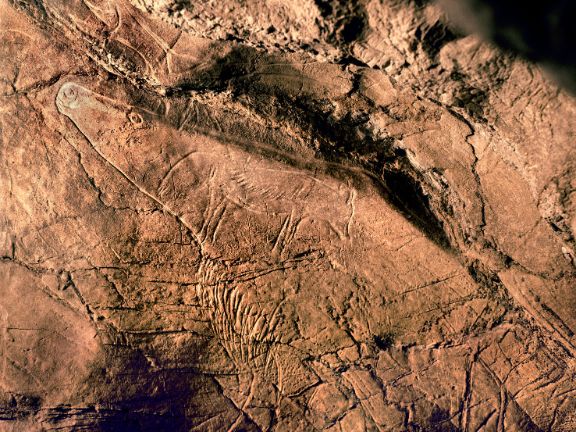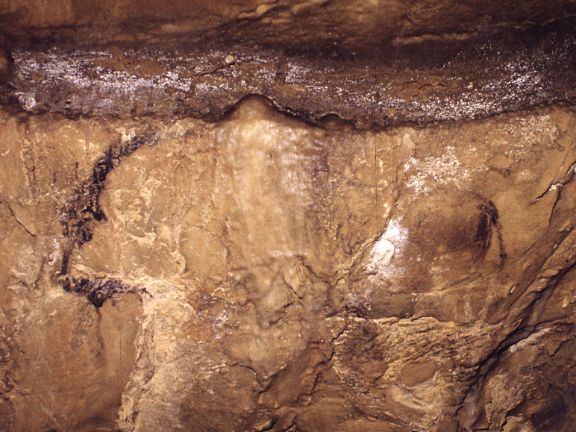Altxerri Cave
Identification of the Property
SubirAia, Gipuzkoa, Basque Autonomous Community
Geographical coordinates
UTM 30T 570319E / 4791198N Z: 20
Description
SubirTopographic description
Altxerri Cave is located in the limestone on the slopes of the hill Monte Beobategaña, scarcely 2 kilometres from the town of Orio, and about 2.5 kilometres from the coast-line. It is a large cave, over two kilometres long, developed with passages on two levels and with a number of interior shafts.
Date of discovery
Discovered in 1969 by members of the Antxieta Kultur Taldea Cultural Association. They made a first tasting and explored the cave after eliminating a landslide that blocked the gallery. The cave was immediately closed.
Archaeological research
The discovery of Altxerri Cave and its cave art took place in two phases. In 1956 work commenced on the road in front of Altxerri country house, and in order to construct this, a temporary quarry was opened up behind the house. One of the dynamite explosions uncovered a hole a metre wide and 80cm high 20 which led into a large wide cave passage. This however only aroused local interest. Six years later, members of the Speleological Section of the Aranzadi Science Society at San Sebastián heard about the cave, and began its exploration. Thus, on 28 October 1962, when the young cavers F. Aranzadi, J. Migliaccio and J. C. Vicuña entered the cave with equipment to descend the shafts in its interior, they discovered the first panels of prehistoric art.
The Speleological Section of San Sebastián Aranzadi Science Society reported the find to J. M. de Barandiaran, who was then the Director of the Society's Prehistory Department. Barandiaran certified the authenticity of the discovery and went on to explore the cave systematically, recording all the depictions that were published in his 1964 report. The assemblage has been re-examined since then by other prehistorians, such as I. Barandiaran. In recent years, a general review has been carried out by A. Ruiz-Redondo, who has established an assignment to the Aurignacian period for Altxerri B.
 Pulse para ampliar
Pulse para ampliar
 Pulse para ampliar
Pulse para ampliar
Artistic contents: paintings and engravings
The cave art corresponds to the model of the so-called “deep shrines” and is located in the main gallery, over 100m from the entrance, and in two side-passages. A total of 140 depictions, including animals and signs, mostly engraved, are known. They are grouped in panels, and in the final part in friezes, that make use of the long surfaces of the limestone strata that form the cave walls.
Regarding the engravings, they show great complexity and variety, and different techniques and styles have been recognised. These range from the drawing of outlines with minimum anatomic details to complicated deeply-scored lines that produce a striped effect and eliminate all reference to the outline and specific anatomic features. This second technique is the most characteristic feature of this cave art ensemble. The paintings are generally found in relation with the engravings; they are usually monochrome outlines with the occasional use of colourwash in their interiors.
A great variety of species are found among the animal figures, including some very rare depictions of a wolverine, saiga antelopes, a snake and a hare. There are also some anthropomorphic figures. The chronology of the shrine is given by the coherence of the style, by parallels with the portable art objects found at other sites, and by the representation of fauna belonging to especially cold climates.
Therefore, the assemblage is dated to a late stage of the upper Magdalenian. The figures have been classified in the following groups: Group I is located in the first side-passage and contains interesting figures of a wolverine, the fore-quarters of a saiga antelope, a fox in association with a reindeer, a bird, two fish and an anthropomorph, as well as a number of ibex and bison.
Group II is situated in the main passage, 12m from the junction with the side passage. It is divided into two panels, both of which take the form of a narrow frieze, with figures of bison, ibex and an aurochs.
Group III is on a vertical face of the opposite wall; it consists of a bison engraved with the unusual deeply scored technique and a painted silhouette, which lacks its fore-legs.
Some four metres away and on the other wall, Group IV is located. It consists of two bison facing head downwards, painted with a black colour-wash in the interior of their bodies and with superimposed engraving. They are associated with signs that are difficult to interpret and further painted and engraved bison and the fore-quarters of a stag.
Group V is on the same wall as Group III, about four metres away, and it is divided into three sub-groups. The second is the most impressive frieze in the assemblage: an ibex facing an aurochs, both painted with a black outline over a deeply-engraved background, a chamois with a bison, another two bison, and the head and neck of a horse in the lower part of the frieze.
Group VI is opposite the previous one. It forms a large panel with figures of bison, reindeer and a snake. The shaft that is the location of Group VII is to the east of Group VI. It contains figures of a stag, a bovid, bison and horse, distributed along the roof and walls.
Salto de línea Less studied are the remains of the upper gallery, Altxerri B, In this place that is difficult to access today, up to 15 graphic units have been described in a large stain of red paint: a large bison, a feline and a bear among others. This group of Altxerri B has been taken to more recent chronologies than those of the main gallery. The performance of his stylistic study, as well as the performance of indirect radiocarbon dating, lead Altxerri B to Aurignacian chronology.Salto de línea
Bibliography
SubirAPELLANIZ, J.M. 1982. El Arte Prehistórico del País Vasco y sus vecinos. Bilbao: DDB.
ALTUNA, J. 1972. Fauna de Mamíferos de los yacimientos prehistóricos de Guipúzcoa (Munibe 24). San Sebastián: Sociedad de Ciencias Aranzadi.
ALTUNA, J. 1975. Lehen Euskal Herria. Guía Ilustrada de Prehistoria Vasca. Bilbao: Ed. Mensajero.
ALTUNA, J., APELLANIZ, J.M. 1976. Las figuras rupestres paleolíticas de la cueva de Altxerri. (Munibe 28). San Sebastián: Sociedad de Ciencias Aranzadi.
ALTUNA, J., ARMENDARIZ, A., ETXEBERRIA, F., MARIEZKURRENA, K., PEÑALVER, X., ZUMALABE, F. 1990. Gipuzkoa. Carta Arqueológica. II. Cuevas. San Sebastián: Sociedad de Ciencias Aranzadi.
BARANDIARAN, I. 1970. Nuevo reno grabado en la cueva de Altxerri (Guipúzcoa). Actas del XI Congreso Nacional de Arqueología: 199-202. Zaragoza: Secretaria de los CNA.
BARANDIARAN, J.M. DE 1964. La cueva de Altxerri y sus figuras rupestres. Munibe 16: 91-141.
BELTRÁN, A. 1964 Avance al estudio de la cronología del arte parietal de la cueva de Altxerri. IV Symposium de Prehistoria Peninsular: 81-92. Pamplona.
BELTRÁN, A. 1968. Notas sobre las técnicas de los grabados de las cuevas de Los Casares y de Altxerri. Simposio Internacional de Arte Rupestre: 21-24. Barcelona.
FERNÁNDEZ G. DE DIEGO, F. 1964 Una pintura paleolítica, gigantesca, de bisonte en la cueva de Altxerri (Guipúzcoa). IV Symposium de Prehistoria Peninsular: 93-98. Pamplona.
GONZÁLEZ-SAINZ, C., RUIZ-REDONDO, A., GARATE, D., IRIARTE, E. 2013. Not only Chauvet: Dating Aurignacian rock art in Altxerri B Cave (northern Spain). Journal of Human Evolution, 65: 457-464.
RAT, P., DELINGETTE, A. 1964. Premières données géologiques sur la grotte ornée d'Altxerri (Aya, Guipúzcoa). Munibe 16: 83-89.
RUIZ-REDONDO, A. 2014. Entre el Cantábrico y los Pirineos: El conjunto de Altxerri en el contexto de la actividad gráfica magdaleniense. Ed. Nadir.
VV.AA. 2012: Altxerri. San Sebastián: Aranzadi Zientzia Elkartea.



